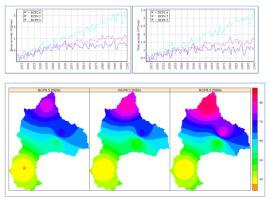Journal of Hydrology ( IF 6.4 ) Pub Date : 2021-01-12 , DOI: 10.1016/j.jhydrol.2021.125974 Birhan Getachew Tikuye , B.R. Manjunatha , H. Gangadhara Bhat

|
This study is being conducted in Lake Tana Basin, Upper Blue Nile River Basin, Ethiopia. This study focuses on the assessment of the separate and combined impacts on water balance components of both climate and LULC change. For calibration, validation and uncertainty analysis, the Soil and Water Assessment Tool (SWAT) was used in conjunction with the IPEAT (Integrated Parameter Estimation and Uncertainty Analysis Tool) package. To produce high resolution future climate data from CanESM2 GCM that could be used for impact assessment, the Statistical DownScaling Model (SDSM) was used while the future LULC prediction was generated using Cellular Automata-Markov Chain model. The hydrological response of the basin was assessed by dividing the future time periods in to 2020s (2011-2040), 2050s (2041-2070), and 2080s (2071-2100) through incorporating three scenarios, such as LULC change alone, climate change alone and combined climate and LULC change. The prediction of the LULC change using the CA-Markov chain model indicates that cropland, tree cover, and built-up areas are likely to increase by 2020s, 2050s, and 2080s at the expense of grassland and shrub cover areas, leading to an increase in evapotranspiration, baseflow and streamflow in the basin. By considering basin average, the climate prediction result suggests an increase in both Tmax (up to 2.14°C) and Tmin (up to 3.2°C) temperatures while precipitation would increase by up to 25% in the basin. The result shows an increase of evapotranspiration by up to 0.84%, 59.8% and 55.5% under LULC, climate and combined climate and LULC change by the end of the 21st century under RCP8.5 compared to the baseline period, respectively. Furthermore, both streamflow and lateral flow are projected to increase by up to 12.85% (9.9%), 28.5% (20.03%) and 26.4% (29.12%) under LULC, climate and combined climate and LULC change scenarios, respectively. As predicted, the shift in magnitude in RCP8.5 emissions is greater than RCP2.6 and RCP4.5. The impacts of climate change on water balances are relatively higher than the combined effects of changes in climate and LULC. Future LULC shifts, on the other hand, change comparatively offsetting hydrological components. In order to devise local-scale adaptation and mitigation strategies, the inclusion of predicted climate and LULC change for hydrological impact studies is therefore very important.
中文翻译:

模拟埃塞俄比亚蓝尼罗河上游塔纳湖盆地的预估气候和土地利用/土地覆盖变化对水文响应的影响
这项研究是在埃塞俄比亚上尼罗河上游的塔纳湖盆地进行的。这项研究的重点是评估气候和LULC变化对水平衡组成部分的单独影响和综合影响。为了进行校准,验证和不确定性分析,将土壤和水评估工具(SWAT)与IPEAT(综合参数估计和不确定性分析工具)软件包结合使用。为了从CanESM2 GCM生成高分辨率的未来气候数据(可用于影响评估),使用了统计缩尺度模型(SDSM),同时使用Cellular Automata-Markov Chain模型生成了未来的LULC预测。通过将未来时期划分为2020年代(2011-2040),2050年代(2041-2070),和2080年代(2071-2100),将三种情景结合起来,例如仅LULC变化,仅气候变化以及气候和LULC变化的结合。使用CA-Markov链模型对LULC变化的预测表明,到2020年代,2050年代和2080年代,耕地,树木覆盖和建成区面积可能会增加,而草地和灌木覆盖区的面积却会增加,流域的蒸散,基流和水流。通过考虑流域平均数,气候预测结果表明,Tmax(最高2.14°C)和Tmin(最高3.2°C)温度都会升高,而流域内的降水最多会增加25%。结果表明,到21世纪末,在LULC,气候以及综合气候和LULC变化的条件下,蒸散量分别增加了0.84%,59.8%和55.5%。仅气候变化以及气候变化和土地利用,土地利用变化和气候变化的结合。使用CA-Markov链模型对LULC变化的预测表明,到2020年代,2050年代和2080年代,耕地,树木覆盖和建成区面积可能会增加,而草地和灌木覆盖区的面积却会增加,流域的蒸散,基流和水流。通过考虑流域平均数,气候预测结果表明,Tmax(最高2.14°C)和Tmin(最高3.2°C)温度都会升高,而流域内的降水最多会增加25%。结果表明,到21世纪末,在LULC,气候以及综合气候和LULC变化的条件下,蒸散量分别增加了0.84%,59.8%和55.5%。仅气候变化以及气候变化和土地利用,土地利用变化和气候变化的结合。使用CA-Markov链模型对LULC变化的预测表明,到2020年代,2050年代和2080年代,耕地,树木覆盖和建成区面积可能会增加,而草地和灌木覆盖区的面积却会增加,流域的蒸散,基流和水流。通过考虑流域平均数,气候预测结果表明,Tmax(最高2.14°C)和Tmin(最高3.2°C)温度都会升高,而流域内的降水最多会增加25%。结果表明,到21世纪末,在LULC,气候以及综合气候和LULC变化的条件下,蒸散量分别增加了0.84%,59.8%和55.5%。使用CA-Markov链模型对LULC变化的预测表明,到2020年代,2050年代和2080年代,耕地,树木覆盖和建成区面积可能会增加,而草地和灌木覆盖区的面积却会增加,流域的蒸散,基流和水流。通过考虑流域平均数,气候预测结果表明,Tmax(最高2.14°C)和Tmin(最高3.2°C)温度都会升高,而流域内的降水最多会增加25%。结果表明,到21世纪末,在LULC,气候以及综合气候和LULC变化的条件下,蒸散量分别增加了0.84%,59.8%和55.5%。使用CA-Markov链模型对LULC变化的预测表明,到2020年代,2050年代和2080年代,耕地,树木覆盖和建成区面积可能会增加,而草地和灌木覆盖区的面积却会增加,流域的蒸散,基流和水流。通过考虑流域平均数,气候预测结果表明,Tmax(最高2.14°C)和Tmin(最高3.2°C)温度都会升高,而流域内的降水最多会增加25%。结果表明,到21世纪末,在LULC,气候以及综合气候和LULC变化的条件下,蒸散量分别增加了0.84%,59.8%和55.5%。导致该盆地的蒸散量,基流和水流增加。通过考虑流域平均数,气候预测结果表明,Tmax(最高2.14°C)和Tmin(最高3.2°C)温度都会升高,而流域内的降水最多会增加25%。结果表明,到21世纪末,在LULC,气候以及综合气候和LULC变化的条件下,蒸散量分别增加了0.84%,59.8%和55.5%。导致该盆地的蒸散量,基流和水流增加。通过考虑流域平均数,气候预测结果表明,Tmax(最高2.14°C)和Tmin(最高3.2°C)温度都会升高,而流域内的降水最多会增加25%。结果表明,到21世纪末,在LULC,气候以及综合气候和LULC变化的条件下,蒸散量分别增加了0.84%,59.8%和55.5%。RCP8.5下的第一个世纪与基准期相比。此外,在土地利用,土地利用变化和气候变化以及气候变化和土地利用和土地利用变化的综合变化情景下,水流量和侧向流量预计分别增加高达12.85%(9.9%),28.5%(20.03%)和26.4%(29.12%)。如预期的那样,RCP8.5排放量的幅度变化大于RCP2.6和RCP4.5。气候变化对水平衡的影响相对高于气候变化和土地利用,土地利用变化和变化的综合影响。另一方面,未来的土地利用,土地利用变化的变化会改变相对抵消的水文要素。为了设计局部尺度的适应和缓解策略,将预测的气候和LULC变化纳入水文影响研究因此非常重要。


























 京公网安备 11010802027423号
京公网安备 11010802027423号